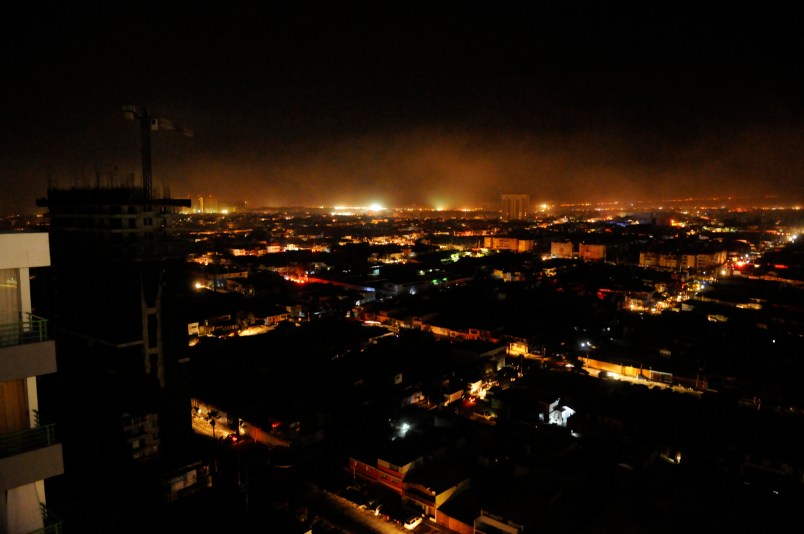SANTIAGO, Chile (AP) — Authorities kept hundreds of thousands of people out of their beds early Wednesday after a magnitude-8.2 earthquake struck off Chile’s northern coast. Five people were crushed to death or suffered fatal heart attacks, a remarkably low toll for such a powerful shift in the Earth’s crust.
The extent of damage from Tuesday night’s quake couldn’t be fully assessed before daybreak, President Michelle Bachelet said, but she wasn’t taking any chances. She declared a state of emergency in the region and sent a military plane with 100 anti-riot police to join 300 soldiers deployed to prevent looting and round up escaped prisoners.
The shaking loosed landslides that blocked roads, knocked out power for thousands, damaged an airport and provoked fires that destroyed several businesses. About 300 inmates escaped from a women’s prison in the city of Iquique. In Arica, another city close to the quake’s offshore epicenter, hospitals treated minor injuries, and some homes made of adobe were destroyed, authorities said. Chilean Interior Minister Rodrigo Penailillo announced the five deaths.
Bachelet’s government extended its tsunami warnings for northernmost Chile long after they were lifted elsewhere. Its mandatory evacuation orders remained in effect until nearly dawn for coastal areas north of Antofogasta, a decision backed by the Pacific Tsunami Warning Center in Hawaii.
“We regard the coast line of Chile as still dangerous, so we’re maintaining the warning,” geophysicist Gerard Fryer told The Associated Press.
Bachelet, who just returned to the presidency three weeks ago, spoke well after midnight, five hours after the quake struck.
It was not lost on many Chileans that the last time she presided over a major quake, days before the end of her 2006-10 term, her emergency preparedness office prematurely waved off a tsunami danger. Most of the 500 dead from that magnitude-8.8 tremor survived the shaking, only to be caught in killer waves in a disaster that destroyed 220,000 homes and washed away large parts of many coastal communities.
“The country has done a good job of confronting the emergency. I call on everyone to stay calm and follow the authorities’ instructions,” Bachelet tweeted after Tuesday night’s temblor.
When she finally addressed the nation, she said her interior minister would monitor the tsunami threat throughout the night and coordinate the emergency response. “Classes have been suspended, and we will be able to know the extent of the damage in the light of day,” she added.
The tsunami warning center cancelled tsunami watches for areas other than northern Chile and southern Peru. The only U.S. impact might be higher waves Wednesday for Hawaii’s swimmers and surfers, it said.
The U.S. Geological Survey initially reported the quake at 8.0, but later upgraded the magnitude of the quake that struck 61 miles (99 kilometers) northwest of Iquique. More than 20 significant aftershocks followed, including a 6.2 tremor. More aftershocks and even a larger quake could not be ruled out, said seismologist Mario Pardo at the University of Chile.
Psychiatrist Ricardo Yevenes said he was with a patient in Arica when the big one hit.
“It quickly began to move the entire office, things were falling,” he told local television. “Almost the whole city is in darkness.”
The quake was so strong that the shaking experienced in Bolivia’s capital about 290 miles (470 kilometers) away was the equivalent of a 4.5-magnitude tremor, authorities there said.
Chile is one of the world’s most earthquake-prone countries because just off the coast, the Nazca tectonic plate plunges beneath the South American plate, pushing the towering Andes cordillera to ever-higher altitudes.
The latest activity began with a strong magnitude-6.7 quake on March 16 that caused more than 100,000 people to briefly evacuate low-lying areas. Hundreds of smaller quakes followed in the weeks since, keeping people on edge as scientists said there was no way to tell if the unusual string of tremors was a harbinger of an impending disaster.
___
Associated Press writers Eva Vergara in Santiago and Frank Bajak in Lima, Peru, contributed to this report.
Copyright 2014 The Associated Press. All rights reserved. This material may not be published, broadcast, rewritten or redistributed.






